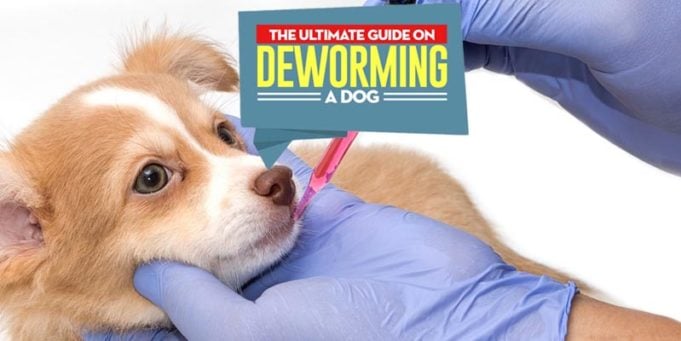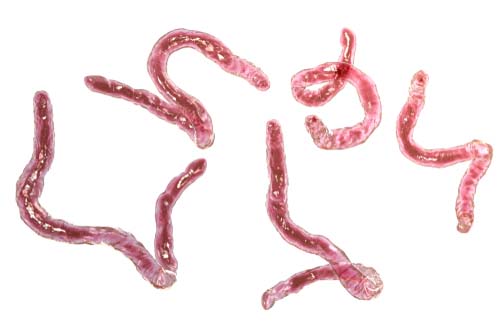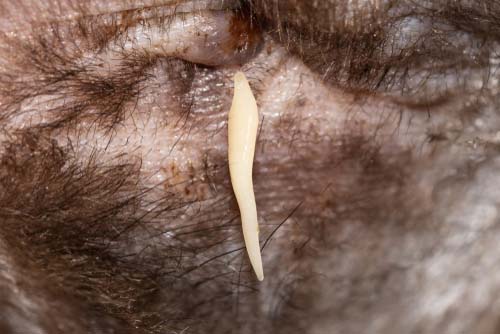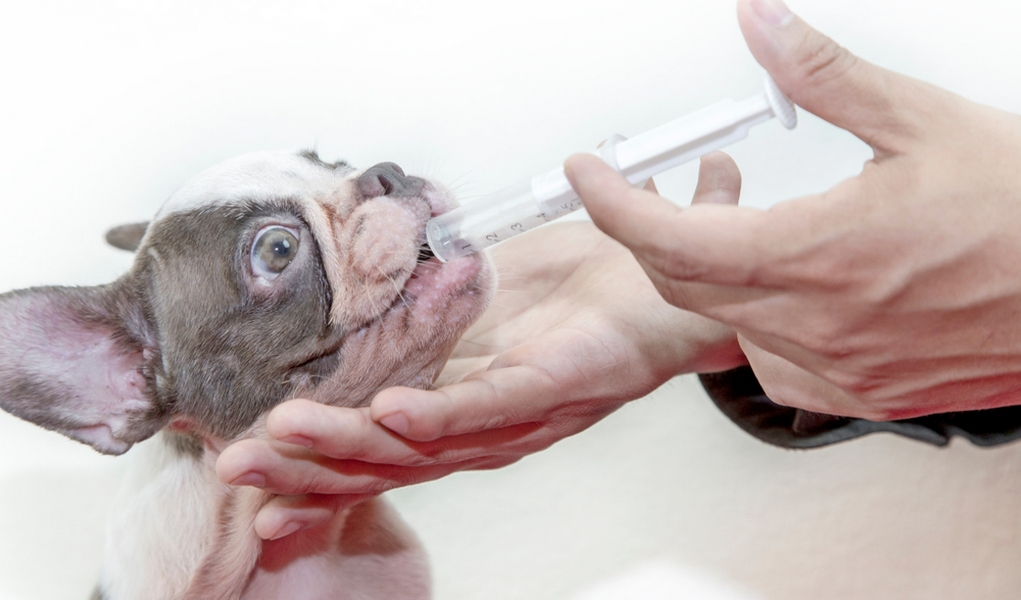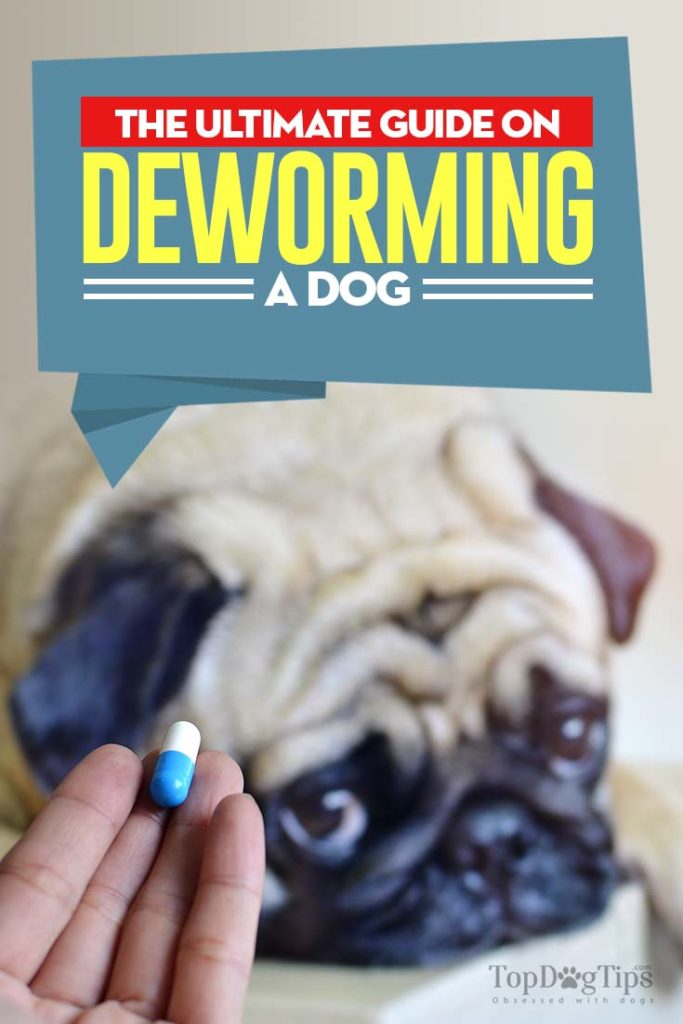Different worm types can infest a dog. These parasites stay alive by leaching blood and nutrients off the host, which causes worm symptoms in dogs. The below guide explains how to prevent worms in dogs, recognize signs and how to deworm a dog effectively.
Table of Contents
These well-fed intestinal parasites will reproduce in the dog's body, and worsen the infestation while spreading via dog's feces. This causes a number of health problems including death due to malnutrition, infection or anemia. Other symptoms of worm infestation will often result in weight loss, diarrhea, irritation of the digestive tract and rectum.
How to Deworm a Dog
There are several types of worms, but the most common are hookworms, roundworms, tapeworms and whipworms. The first three can be prevented with a canine dewormer. The last one will require the use of heartworm medication.
The prevalence of worm infestation in a dog depends on several factors including the environment and even seasonality. Any owner looking to learn how to deworm a dog must know which type of worm they're dealing with, because the procedures will differ.
1. Hookworms in Dogs
Hookworms are so named because once they infest a dog’s intestinal tract, they literally hook themselves into the intestinal lining. They do this via a hook-shaped mouthpiece (see picture on the right) which they use to feed off a dog’s blood vessels.
Hookworms cannot be seen with the naked eye. Dogs can contract them through oral ingestion, in utero, through skin contact, or through mother’s milk. Hookworms are extremely contagious and even once eliminated can re-infect a dog if they come into contact with excreted eggs.
Symptoms of hookworm infestation in dogs include anemia, weakness, bloody diarrhea, pale gums, weight loss, itchy paws, poor growth, and even death. Hookworms are diagnosed through a fecal test at your veterinarian’s office. The most effective treatment for hookworms in dogs is administering a dewormer; however, recent studies are showing that worms in dogs in the USA may become resistant to many popular drugs.
This is what a hookworm looks like:
Fact sheet on hookworms in dogs:
How can a dog get hookworms? Through ingestion of poop, or living in a highly feces contaminated area. Through mother's milk in puppies; very common in dog breeders. Eating a hookworm infected animal (like rodents, or hunting prey) can also result in infestation.
Can people contract hookworms? Yes, but only through the environment.
What signs of hookworms to look for? Adult dogs do not show any signs of infestation. Puppies with heavy hookworm infection may have diarrhea, weight loss, look very ill and be anemic (charcoal feces, pale skin).
How to diagnose hookworms? Through feces exam only.
How to deworm a dog for hookworms? Using a canine dewormer (anti-parasitic) medication. Cleaning up the environment is an essential step to preventing further infestation. Severe cases of hookworms, especially in puppies, may require hospitalization and fluid therapy.
What are the dog's recovery chances? Chances are good in majority of cases: a dog dewormer medication treatment works quickly and most dogs respond well to it.
How to prevent hookworm infestation? Using a regular schedule for deworming your dog and following strict protocols for removing dog poop from the environment.
2. Roundworms in Dogs
Roundworms are one of the most commonly seen parasites in dogs, particularly in young puppies. There are two varieties of roundworm that can infect dogs – Toxocara canis and Toxacaris leonina. The roundworm Toxocara canis is the more dangerous of the two, and it can also be transmitted to humans.
Upon infection, roundworms live in a dog’s intestinal tract where they consume partially digested food. This can lead to deprivation of nutrients and symptoms of malnourishment or anemia in your dog.
Most often, dogs will become infected with roundworms via their mother at birth or through her milk. Roundworms can also be contracted through ingesting eggs or eating other animals infected with the worm.
Symptoms of a dog roundworm infestation include a potbelly, clear signs of malnutrition, worms in the stool or vomit, coughing, and diarrhea. When worms are vomited or excreted out they may or may not still be moving. Roundworms are diagnosed through a fecal test at your veterinarian’s office. Treatment includes administering a dog dewormer.
This is what a roundworm looks like:
Fact sheet on roundworms in dogs:
How can a dog get roundworms? Through licking, eating or sniffing poop, or living in a highly feces contaminated area. Through mother's milk in puppies; very common in dog breeders. Eating a roundworm infected animal (like rodents, or hunting prey) can also result in infestation.
Can people contract roundworms? Toxacaris leonina roundworm cannot be transmitted to humans. Toxacaris canis can be transmitted to humans through the ingestion of larvae (most common in kids).
What signs of roundworms to look for? Stunted growth, potbelly, and recurrent diarrhea.
How to diagnose roundworms? Through feces exam only.
How to deworm a dog for roundworms? Using a canine dewormer (anti-parasitic) medication. Cleaning up the environment is an essential step to preventing further roundworm infestation.
What are the dog's recovery chances? Chances are good in majority of cases: a dog dewormer medication treatment works quickly and most dogs respond well to it.
How to prevent roundworm infestation? Using a regular schedule for deworming your dog and following strict protocols for removing dog poop from the environment.
3. Tapeworms in Dogs
Tapeworms are another parasite that takes up residence in a dog’s intestinal tract. These flat and segmented worms can live in a wide variety of species, including humans.
Tapeworms in dogs are usually contracted when a flea that is infested with tapeworm eggs is eaten. These eggs then wind up in your dog’s digestive tract where they develop into adults. As the worm grows larger, small rice-like segments of the worm break off and are excreted in your dog’s feces. These excreted pieces of tapeworm contain eggs which may then be ingested by other animals.
Dog tapeworm infestation usually does not result in symptoms. If the dog tapeworm infestation is heavy, the animal may get very thin and/or fail to gain weight. Most pet owners only notice tapeworm infestations in their dogs when they see small rice-like pieces in the dog’s feces.
Tapeworms are diagnosed through a fecal test at your veterinarian’s office. Treatment includes a de-wormer – usually praziquantel. Dogs can pass tapeworm to their owner; however, the chances are low since the human would have to ingest an infected flea or eggs in feces.
This is what a tapeworm looks like:
Fact sheet on tapeworms in dogs:
How can a dog get tapeworms? Through self-grooming by ingesting tapeworm eggs (for example, from a flea). Through licking, eating or sniffing poop, or living in a highly feces contaminated area. Eating a tapeworm infected animal (like rodents, or hunting prey) can also result in infestation.
Can people contract tapeworms? Yes, but the risk is very low because a human would need to ingest feces with tapeworm eggs.
What signs of tapeworms to look for? Weight loss may occur, but tapeworms aren't as dangerous as some other worm parasites in dogs. Tapeworms can be sometimes seen around the dog's anus or in his feces. Dogs also often scratch their anus on the carpet when tapeworms irritate that area.
How to diagnose tapeworms? Through feces exam.
How to deworm a dog for tapeworms? Using a canine dewormer (anti-parasitic) medication. Cleaning up the environment is an essential step to preventing further tapeworm infestation.
What are the dog's recovery chances? Chances are good in majority of cases: a dog dewormer medication treatment works quickly and most dogs respond well to it.
How to prevent tapeworm infestation? Using a regular schedule for deworming your dog and following strict protocols for removing dog poop from the environment.
4. Whipworms in Dogs
Whipworms (or Trichuris vulpis) are shaped like a whip and live inside a dog’s intestinal tract once an infection sets in. The thicker end of this tapered worm attaches to the intestinal lining in the large intestine. These attached worms feed on blood vessels in the intestinal tissue.
The dog whipworm is more rare, but it's one of the most pathogenic worm types, and it's the most dangerous as it causes more serious health consequences. Symptoms of a dog whipworm infection include diarrhea, irritation, bloody stool, anemia, and weight loss. In severe infestation, whipworms can cause death.
Whipworms are contracted from the environment when an infected dog passes eggs in their stool. The eggs are resistant to the environment and can remain alive for up to 5 years. These eggs become infective in the environment after 10 to 60 days when they can re-infect a dog. Once ingested, these eggs mature in the dog’s intestinal tract and the cycle begins again.
Whipworm in dogs is particularly nasty and can very quickly cause serious problems. Diagnosis requires a fecal test at your veterinarian’s office. Treatment requires a de-wormer. Of all parasites, whipworms are one of the hardest to get rid of. Their eggs can live for as long as FIVE years in the environment which makes re-infection highly likely.
This is what a whipworm looks like:
Fact sheet on whipworms in dogs:
How do whipworms spread? Through ingestion of whipworm eggs, which can be found in poop, water, food, etc.
Can people contract whipworms? No.
What signs of whipworms to look for? Signs of whipworms in dogs aren't always apparent. During a heavy whipworm infestation, the dog may experience weight loss, diarrhea, bloody stool and show signs of anemia.
How to diagnose whipworms? Through a much more thorough, several step feces exam.
How to deworm a dog for whipworms? Using two separate treatments as advise by a veterinarian, spaced out in several week intervals. Alternatively, using a heartworm preventative that contains a whipworm medication in it.
What are the dog's recovery chances? Chances are good with the right treatment. A vet's approach, or using a heartworm medication works quickly and most dogs respond well to it.
How to prevent whipworm infestation? Whipworms are rare, but switching to a heartworm medication can help to prevent re-infestation.
Other Important Dog Deworming Questions
Can Humans Get Worms from Dogs?
Yes – humans can get certain types of worms from dogs. This is rare, however.
Most parasites are species specific. This means that while humans and dogs may contract the parasite, the particular species of parasite is unique. In some more rare instances, a particular species of parasite can infect both humans and dogs.
This type of parasite is referred to as being “zoonotic”. Among worms, only hookworms and roundworms are zoonotic. Tapeworm and whipworm may be zoonotic only on occasion, but the instances of this happening are very low or almost non-existent.
How Often to Deworm Dogs?
All species of worms require veterinary intervention. Learning how to deworm a dog requires administering a canine de-wormer as well as treatment of symptoms. This may include flea baths, IV fluids and overnight monitoring. For some worms, like whipworms, a dog will need to take a heartworm medication instead.
A veterinarian will manage your dog’s initial deworming treatment. Most commonly, the first deworming series is given by a breeder or shelter with puppy vaccinations. This series includes deworming at 2 weeks, 4 weeks, 8 weeks, 12 weeks and 16 weeks. This means a puppy should already have had three sets of deworming treatments before coming home.
The next deworming treatment is usually given at 6 months and 12 months. At this point, your dog should be protected against parasite infestation through monthly heartworm preventatives. If a dog manages to contract worms at any other time during their adult life, they should be treated accordingly after a confirmed veterinary diagnosis.
How Much is Deworming for Dogs Going to Cost?
The cost of deworming in dogs to prevent common worm types depends on the dog's size. In the US, deworming costs usually start at $5 and go up from there to about $50-60. For example, here's a cost sheet from one clinic and from another.
This is done by using either a vet prescribed dewormer (which they give only after assessing your individual dog) or using the standard dog dewormer brands which pet owners can also purchase over the counter themselves.
Heartworm treatment – which isn't always done for common worm types mentioned above but does cover dogs for almost all worm infestations – is much more expensive. For example, a dog heartworm test will cost $40-50 and if heartworms are detected in the dog, the treatment may cost anywhere from $500 to $1000.
How Long After Deworming a Dog are the Worms Gone?
Most dog dewormers begin working immediately, and you can expect to see the results within a few hours. Worms may continue leaving your dog's body for several days.
If your dog have successfully swallowed the tablet, chew or liquid and there were no side effects such as vomiting or diarrhea, then it's safe to assume that the dewormer is now effectively working to rid the dog's body of worms in one of two ways.
Some dewormers paralyze worms which are then found in a dog's poop. Other dewormers may kill and break up worms, making it less likely for you to see the worms leaving a dog's body. In cases of severe worm infestation, a dog may also vomit out some worms.
After initial deworming, it's important to keep up with a deworming schedule for the dog because your pet can easily get reinfected.
Best Dewormers for Dogs
When you're attempting to learn how to deworm a dog, it's important to check with your veterinarian before using any over-the-counter dewormer medication. Most popular and frequently used dog dewormers to treat common parasites are Drontal and Panacur.
Drontal Plus
Drontal Plus (not to be confused with Drontal for cats and kittens) made by Bayer Animal Health contains the active ingredients praziquantel, pyrantel pamoate, and febantel.
- Broad spectrum dewormer for...
- For cats and kittens over 1...
- Give one tablet per 4-8 lbs....
- May be given directly by mouth...
Praziquantel causes the parasite to disintegrate by damaging the skin. Pyrantel pamoate paralyzes other types of worms so they lose their grip on the intestinal wall. Febantel interferes with the formation of the parasite, particularly in whipworms.
Drontal Plus is used to treat tapeworms, hookworms, roundworms, and whipworms. It can be used in puppies 3+ weeks old that weight 2lbs or more, but is often used for 2 week old deworming as well.
Panacur C
Panacur C contains the active ingredient fenbendazole, an anti-parasitic which damages the cells of the parasite. Fenbendozale is also available under brand name Safe-Guard.
- Mix the daily dose with a...
- Repeat the daily dose for 3...
- If dog's weight is in-between...
- Safe for all dogs 6 weeks and...
- Deworming schedules may vary...
Panacur C is effective against roundworms, hookworms, whipworms, and tapeworms. It can be used in puppies 6+ weeks old although many people use it for puppies beginning at 2 weeks. If you're looking for ways on how to deworm a dog yourself, Panacur C is the best place to start.
Currently, it's one of the most popular OTC dog dewormers out there, alongside the Safe Guard Canine Deowrmer. With Panacur C, you need to give the medication once a day for three days straight, and the dose depends on your dog's body weight. While some pet owners have expressed negative views towards many other dewormers for dogs, majority agree that Panacur C has been the most effective dog dewormer treatments for their pets.
How Does a Dog Dewormer Work?
Different dewormers for dogs work in different ways depending on their active ingredients and the type of worm they are designed to target. Most broad-spectrum de-wormers target the cellular structure of the parasite to destroy them from the inside out.
Dewormers are usually given to very young puppies as a liquid formula via an oral syringe. In older dogs, chewable tablets are preferable, since they require less fuss and ensure the dog gets the full dose of dewormer.
How Much Dewormer to Give a Dog?
In majority of cases, it's best to consult with a veterinarian if this is the first time that you're giving a dog dewormer. This will depend on the dog's age and size, and especially if any other health conditions need to be considered. Below is a rule of thumb on how much dewormer to give a dog.
Puppies
-
- Every 2 weeks until 3 months of age
- Once a month from 3-6 months of age
Adult and Senior Dogs
-
- Regular treatment as per dewormer's and/or vet recommended schedule
- It's strongly advised to get a fecal test every year
Can Dogs Get Sick from Deworming?
It is rare for dogs to have a reaction to dewormers. In few instances, dogs may have symptoms from de-wormers including diarrhea, vomiting or loss of appetite.
Dogs that are more susceptible to side effects of medications include the very young, the elderly, those with other health conditions, and those that are immune-compromised. These dogs are also those that are most likely to suffer complications from parasite infection. The possibility of side effects from de-worming is much lower than the potential for complications resulting from parasite infestation.
How Can I Deworm My Dog Naturally?
When you search online, there may be websites advising on how to deworm a dog naturally. However, remember that no natural treatments for existing worms (that have already infested your dog) will be effective. The only potentially effective home remedies that are natural can be used for preventing worms in dogs.
In this guide, Samantha explains how you can prevent dog worm infestation naturally and the supplies you'll need, such as certain foods, probiotics and apple cider vinegar. This guide explains more about natural treatments for ringworm in dogs.
How to Deworm a Dog with Tobacco?
A small amount of pinched chewing tobacco added into a dog's food should drive worms out of the dog's body without harming the dog. This process is self-explanatory, but remember that this has not been tested properly and is only advised by other pet owners based on anecdotal evidence.
If you're going to spend money on chewing tobacco, we recommend to simply buy a proven dewormer for dogs instead which you know to be safe. Because we have no studies on how chewing tobacco, even in small amounts, can affect pets, we'd recommend to avoid this natural method.
Table of Heartworm Medication for Dogs
When you're learning how to deworm a dog, it's important to find the deworming medication that will meet all of your needs. Most heartworm preventatives on the market today include a dewormer intended to target the most common worms in dogs. Pay attention to the type of heartworm medication you purchase, however, since not all of them protect against every parasite.
The table below shows some of the more common heartworm preventatives and what they protect against. You cannot buy these over-the-counter on Amazon, and you'll need to consult with a vet beforehand.
| BRAND | Heartworm | Roundworm | Hookworm | Whipworm | Tapeworm |
| Trifexis | x | x | x | x | |
| Heartguard Plus | x | x | x | ||
| Sentinel Spectrum | x | x | x | x | |
| Interceptor Plus | x | x | x | x | x |
| Sentinel | x | x | x | x | |
| Iverhart Max | x | x | x | x | |
| Interceptor | x | x | x | x |
The Bottom Line
As parasites, worms have far more potential to harm your dog than most people realize. This is why it's so important for every dog owner to learn how to deworm a dog. In fact, if left without treatment, many dogs can succumb to worm infestations – some in just a matter of days.
If you notice any signs of worms in your dog, pay a visit to your vet immediately to stop the progression of the infestation and to protect others. Your veterinarian can teach you how to deworm a dog and guide you in choosing the right dewormer for your pet.
READ NEXT: The Ultimate Dog Fleas and Ticks Survival Guide
Disclosure: We may earn affiliate commissions at no cost to you from the links on this page. This did not affect our assessment of products. Read more here and find full disclosure here.


